|
Thursday, Nov. 2
- Breakfast: Greek omelet
- Vegetarian chili
- Barbecue chopped-pork sandwich
- Southern fried chicken
- Smart cuisine: stir-fried vegetables
- Italian loaf sandwich
- Assorted pizza by the slice
- Tex-Mex grilled-chicken salad
Wilson Hall Cafe Menu |
|
Friday, Nov. 2
Dinner
- French onion soup
- Grilled swordfish with white wine
- Butter sauce with capers
- Corn risotto
- Sautéed pea pods with red peppers
- Almond cake
Wednesday, Nov. 7
Lunch
- Chicken in a coconut curry
- Steamed jasmine rice
- Vanilla flan with mango sauce
Chez Leon Menu
Call x3524 to make your reservation.
|
|
What else could the Higgs be?
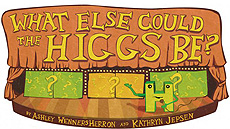 |
According to the Standard Model, the mass of the Higgs boson should be enormous. But recent experimental results suggest it's quite small, indicating that scientists might need to go beyond the Standard Model to explain the new particle. Image: Sandbox Studio, Chicago
|
On July 4, scientists around the world popped open champagne bottles and toasted the culmination of nearly five decades of research. They had discovered a new particle, one that looked awfully similar to the long-sought Higgs boson.
The Higgs boson has for decades been the last missing piece of the Standard Model of particle physics. But even if the new particle completes the puzzle, some of its pieces still refuse to fit.
"If it's the Standard Model Higgs boson, the picture will be complete, but it won't be satisfying," says Eilam Gross, co-convener of the ATLAS Higgs physics group. "There are questions we can only begin to answer by going beyond the Standard Model."
As the theory tells it, particles gain mass by wading through a kind of force field. Imagine holding a handful of sand. Cup your hands together and apply some pressure. Open your hands. If the sand is dry, it shifts and dissipates. If it's wet, it'll hold the shape you pressed it into. The idea is the same for how particles gain mass. Just as the sand gains a new shape depending on its level of moisture, particles gain mass depending on their level of interaction with the Higgs field.
In return, the Higgs boson gains mass through its interactions with other particles—and through its interactions with itself.
Interactions with one group of particles add huge amounts of mass to the Higgs, and interactions with another, smaller group of particles subtract it. When the math is done, the mass of the Higgs should add up to an astronomical number. Considering this, the mass at which scientists found the possible Higgs, about 125 gigaelectronvolts, is surprisingly small.
If the particle is indeed a Higgs boson, theories beyond the Standard Model can account for its confusing mass. Three popular explanations involve the ideas of supersymmetry, compositeness and extra dimensions.
Read more
—Ashley WennersHerron and Kathryn Jepsen
|
November wellness offerings, fitness classes and discounts
November's wellness offerings include the Fall Book Fair, free wellness classes, fitness classes, employee league and club information and employee discount information.
Fall Book Fair:
Thursday, Nov. 15, from 10 a.m. to 3 p.m. and Friday, Nov. 16, from 8 a.m. to 2 p.m. in the Wilson Hall atrium.
Free wellness class:
Weekly Qi Gong, Mindfulness and Tai Chi Easy for Stress Reduction meets Wednesdays, 7 to 8 a.m. and Fridays, noon to 1 p.m. in Ramsey Auditorium.
Fitness classes:
- Butts and Guts meets Thursdays, Nov. 1 to Dec. 20 (no class Nov. 22 or 29), from noon to 12:45 p.m. in the Fitness Center. $46/person.
- Kyuki-Do meets Mondays and Wednesdays, Nov. 5 to Dec. 12, from 5 to 6 p.m. in the Fitness Center. $60/person.
Employee league:
Winter volleyball league meets on Mondays from 6 to 9 p.m. in the Fitness Center. To subscribe to the fnal_volleyball e-mail list, send an e-mail to listserv@fnal.gov. Leave the subject blank, and in the body of message type "subscribe fnal_volleyball" (do not type quotation marks).
Employee club:
Garden Club meets on Wednesday, Nov. 14, from noon to 1 p.m. in the Hornet's Nest, WH8X.
Employee discounts:
- Country House Restaurant in Geneva
- AMC and Regal movie tickets
For more information, contact Jeanne Ecker in the Wellness Office at x2548 or at jecker@fnal.gov.
|
The 2012-2013 Users' Executive Committee
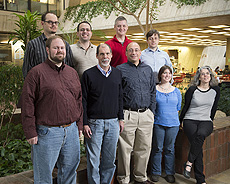 |
Members of the 2012-13 Users' Executive Committee. Top row, from left: Craig Group, former FSPA representative Chris Prokop, Breese Quinn, Sergo Jindariani. Bottom row, from left: Bob Zwaska, Lee Roberts, Nikos Varelas, chair, Mandy Rominsky, Mary Anne Cummings. Not pictured: Daniel Kaplan, Ryan Patterson, Greg Pawloski, Greg Snow. Photo: Reidar Hahn |
Fermilab users recently elected six new officers to the Users' Executive Committee for the 2012-2013 term. UEC handles the affairs of the Fermilab Users' Organization. It provides a forum for discussion of scientific and administrative matters relevant to the organization and functions of the laboratory. Members of the UEC serve as a communication channel between the Fermilab user community and laboratory management. UEC members also participate in public outreach and quality of life activities, organize visits to congressional offices and coordinate the annual Fermilab Users' Meeting. |
Theorists bridge space-time rips
From Nature, Oct. 30, 2012
Could an analysis based on relatively simple calculations point the way to reconciling the two most successful — and stubbornly distinct — branches of modern theoretical physics? Frank Wilczek and his collaborators hope so.
The task of aligning quantum mechanics, which deals with the behaviour of fundamental particles, with Einstein's general theory of relativity, which describes gravity in terms of curved space-time, has proved an enormous challenge. One of the difficulties is that neither is adequate to describe what happens to particles when the space-time they occupy undergoes drastic changes — such as those thought to occur at the birth of a black hole. But in a paper [by A. D. Shapere et al.] posted to the arXiv preprint server on 15 October, three theoretical physicists present a straightforward way for quantum particles to move smoothly from one kind of 'topological space' to a very different one.
Read more |
|
Charm quark's light reveals riddles in theory
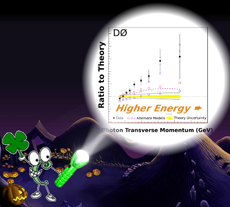 |
Events containing a charm quark and a photon allow physicists to shed light on the behavior of the strong force.
|
When DZero physicists scrutinize events in their data that contain a charm quark and a photon, they can shed light on the behavior of the strong force. In the Standard Model, it is difficult to accurately predict quark production because of the complex strong force interactions involved. Instead, theorists build models of the strong force that must be constrained by experimental data. On the other hand, the interaction of photons, or particles of light, with quarks is well understood. So when a photon is involved in an event with quarks, it lights the way to test different models of the strong force, as was done in a recent analysis from DZero.
The first challenge in this analysis was to identify events that contained a photon and a charm quark, instead of some other flavor of quark. A quark will turn into a spray of particles, called a jet, after it is produced. While lighter quarks turn into a jet immediately, heavier charm quarks and bottom quarks form short-lived composite particles that may travel a few millimeters before decaying. This displaced decay within a jet allows it to be identified as containing either a charm quark or bottom quark. Properties of the displaced decay allowed analyzers to determine the ratio of charm quarks to bottom quarks found in the data.
The analyzers compared the events containing a photon and a charm quark to various theoretical models in two ways. The total rate of production for these events was measured for different ranges of the photon's energy. While some predictions described either the low or the high photon energy range well, no single model described the full range properly. Analyzers also compared the data to theoretical models of the ratio of photon and charm quark production to photon and bottom quark production. They again found that no single prediction accurately described the data, but suggested specific adjustments that led to good agreement. This information will provide important constraints that will improve future models of the strong force interaction.
—Mike Cooke
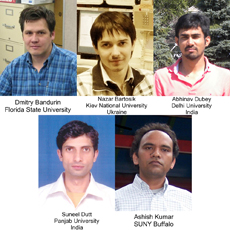 |
| These physicists made major contributions to this analysis.
|
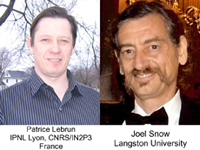 |
| Comparing the Standard Model prediction of a process to the data is often performed by simulating individual events of that process many times, perhaps millions or more. This team coordinates the production of a shared library of simulated events for use in DZero analyses.
|
|
Rocky III report
Some readers pointed out that Craig Hogan's column yesterday could leave the impression that the Rocky III report recommended a follow-up that was specific to the Dark Energy Camera. The Rocky III report only recommends a wide field spectroscopic survey without specifying where it should be done. Hogan has updated the archived column to remove this confusion.
|
Frightful fun on 15th floor
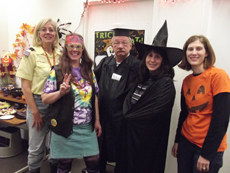 |
This year's 15th-floor Halloween costume contestants were teams WH15 Northeast, WH15 Northwest, WH15 Southeast, WH15 Southwest and International Services on the first floor. The winners, pictured here, are the employees working in WH15 Southeast. Congratulations. Photo: Karen Karlix, WDRS |
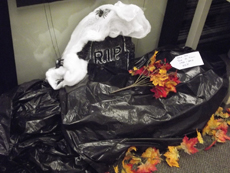 |
Employees on the 15th floor honor Tev A. Tron, 1983-2011, in a manner befitting the holiday. Photo: Nicole Gee, WDRS |
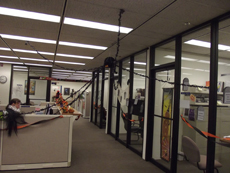 |
Fred the Spider adds a spooky touch to WH15NE. Photo: Nicole Gee, WDRS |
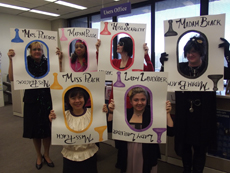 |
Who committed the crime, where and with what? Only the members of the International Services office know. Photo: Nicole Gee, WDRS |
|
|